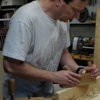Some time back I bought a Hock iron for my #4. While it works very well and holds a good edge, it took forever to get the back flat. This weekend I bought a Hock iron for my 60 1/2. I wanted to try the IBC but my local Woodcraft was out of stock. Anyway I now have no less than 3 hours in it trying to get the back flat. There is about a 3/16" triangle shaped area just opposite the cutting edge in one corner that still is visibly not changing. I started with 180 grit paper on a granite surface plate after seeing that my 250 King waterstone wasn't going to do the job. I thought the 180 did the trick untill I went back to the 250 and then 1,000 stones.
Is this normal for an expensive blade or did I just get 2 bad ones?
Thanks,
Bob Warfield




 Reply With Quote
Reply With Quote


